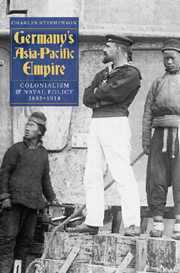Book contents
- Frontmatter
- Contents
- List of Illustrations
- List of Maps and Tables
- Introduction
- 1 Bismarck and Empire: 1885–1888. Kaiser Wilhelm's Land, the Bismarck Archipelago, the Marshall Islands and Nauru
- 2 The Acquisition of Kiautschou: 1897
- 3 China 1897–1914: Colonial Development and Political Turbulence
- 4 Tectonic Shift 1: 1898–1899. Spain and the USA, Germany, Micronesia and Samoa
- 5 Tectonic Shift 2: 1902–1914. Japan and Russia, Britain and Dominion Defence, the United States
- 6 War. August 1914
- 7 Naval Plans and Operations 1897–1914
- 8 Kiautschou: Naval and Military Operations 22 August–28 September 1914
- 9 Tsingtau: Naval and Military Operations 28 September–7 November 1914
- 10 Aftermath
- Notes to the Text
- Bibliography
- Index
3 - China 1897–1914: Colonial Development and Political Turbulence
Published online by Cambridge University Press: 12 September 2012
- Frontmatter
- Contents
- List of Illustrations
- List of Maps and Tables
- Introduction
- 1 Bismarck and Empire: 1885–1888. Kaiser Wilhelm's Land, the Bismarck Archipelago, the Marshall Islands and Nauru
- 2 The Acquisition of Kiautschou: 1897
- 3 China 1897–1914: Colonial Development and Political Turbulence
- 4 Tectonic Shift 1: 1898–1899. Spain and the USA, Germany, Micronesia and Samoa
- 5 Tectonic Shift 2: 1902–1914. Japan and Russia, Britain and Dominion Defence, the United States
- 6 War. August 1914
- 7 Naval Plans and Operations 1897–1914
- 8 Kiautschou: Naval and Military Operations 22 August–28 September 1914
- 9 Tsingtau: Naval and Military Operations 28 September–7 November 1914
- 10 Aftermath
- Notes to the Text
- Bibliography
- Index
Summary
The seizure of Kiautschou was to have profound and almost immediate consequences for China, and indeed the peace of the whole East Asian region, inasmuch as it was the first in a series of such manoeuvres characterised as the ‘Scramble for Concessions’. In December 1897 Russian warships anchored at Lushun (Port Arthur) and Darien (Talienwan) under the pretext of protecting China against the Germans. Indeed, some scholars have contended that protests in respect to German actions became somewhat muted when Foreign Minister Count Muraviev realised that it would provide an excuse for Russian expansion in a like manner. Russia had need of a warm-water naval base, such as Port Arthur, and accordingly, following ‘negotiations’, the Chinese government signed a treaty on 27 March 1898 ceding the Liaodong Peninsula, including Port Arthur and Darien, to Russia for twenty-five years, and granting a concession for a railway to be constructed from Harbin to Port Arthur.
This Russian move prompted Britain to obtain additional Chinese territory on the Kowloon Peninsula on a 99-year lease, and at the same time acquire Weihaiwei (Weihai), ‘one of theleast lustrous gems in Queen Victoria's imperial tiara’. The British occupation of the latter, a 738 square-kilometer area located near the tip of the peninsula on the north-eastern coast of Shandong (Shantung) Province, was to last, from 1 July 1898, ‘for so long a period as Port Arthur shall remain in the occupation of Russia’.
- Type
- Chapter
- Information
- Germany's Asia-Pacific EmpireColonialism and Naval Policy, 1885–1914, pp. 31 - 48Publisher: Boydell & BrewerPrint publication year: 2009

